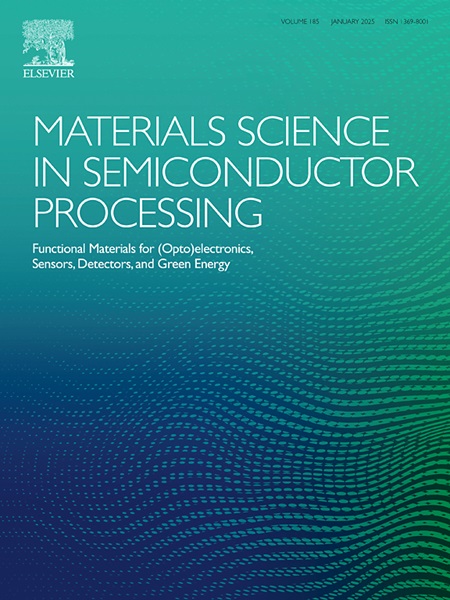改进纳米多孔硅微电容的n掺杂类石墨烯涂层
IF 4.6
3区 工程技术
Q2 ENGINEERING, ELECTRICAL & ELECTRONIC
引用次数: 0
摘要
硅片是集成电子器件的主要平台,多孔硅(pSi)是一种很有前途的片上微电容器电极材料。提出了一种通过在pSi表面沉积氮掺杂类石墨烯涂层(N-GLC)来提高其电化学效率的方法。N-GLC首先用于覆盖整个80 μm pSi层。在化学气相沉积(CVD) N-GLC过程中,急剧的压降允许n掺杂碳沉积在整个孔的整个深度。石墨N (N- glc中氮的主要构型)提高了复合材料的导电性。此外,还研究了GLC在pSi中的渗透深度对其电容的影响。介绍了3M H2SO4的电化学阻抗谱、循环伏安法和恒流充放电数据以及循环稳定性测量结果。高电容(145 mF/cm2)和出色的循环稳定性(即使在低扫描速率下也超过20,000次循环)实现了pSi微电容器电极。据报道,只有在离子电解质和/或在硅纳米线上附加MnOx涂层时,才会有更高的值-形貌相似的材料需要复杂的技术。本文章由计算机程序翻译,如有差异,请以英文原文为准。
N-doped graphene-like coating for improved microcapacitance of nanoporous silicon
Silicon wafers are the main platform for the integrating of electronic devices, porous silicon (pSi) is a promising material for on-chip microcapacitor electrodes. A method is proposed to improve the electrochemical efficiency of pSi by depositing a nitrogen-doped graphene-like coating (N-GLC) on it. N-GLC is first used to coat the entire 80 μm pSi layer. The sharp pressure drops during chemical vapor deposition (CVD) of N-GLC allow N-doped carbon to be deposited throughout the full depth of the pores. Graphitic N (the main configuration of nitrogen in N-GLC) enhances the conductivity of the composite. Moreover, the influence of GLC penetration depth in pSi on its capacitance is investigated.
Electrochemical impedance spectra, cyclic voltammetry, and galvanostatic charge-discharge data in 3M H2SO4 are presented along with the results of cyclic stability measurements. High capacitance (145 mF/cm2) and excellent cyclic stability (over 20,000 cycles even at low scan rates) are achieved for a pSi microcapacitor electrode. Considerably higher values have been reported only in ionic electrolytes and/or with an additional MnOx coating on silicon nanowires – morphologically similar materials that require complicated technology.
求助全文
通过发布文献求助,成功后即可免费获取论文全文。
去求助
来源期刊

Materials Science in Semiconductor Processing
工程技术-材料科学:综合
CiteScore
8.00
自引率
4.90%
发文量
780
审稿时长
42 days
期刊介绍:
Materials Science in Semiconductor Processing provides a unique forum for the discussion of novel processing, applications and theoretical studies of functional materials and devices for (opto)electronics, sensors, detectors, biotechnology and green energy.
Each issue will aim to provide a snapshot of current insights, new achievements, breakthroughs and future trends in such diverse fields as microelectronics, energy conversion and storage, communications, biotechnology, (photo)catalysis, nano- and thin-film technology, hybrid and composite materials, chemical processing, vapor-phase deposition, device fabrication, and modelling, which are the backbone of advanced semiconductor processing and applications.
Coverage will include: advanced lithography for submicron devices; etching and related topics; ion implantation; damage evolution and related issues; plasma and thermal CVD; rapid thermal processing; advanced metallization and interconnect schemes; thin dielectric layers, oxidation; sol-gel processing; chemical bath and (electro)chemical deposition; compound semiconductor processing; new non-oxide materials and their applications; (macro)molecular and hybrid materials; molecular dynamics, ab-initio methods, Monte Carlo, etc.; new materials and processes for discrete and integrated circuits; magnetic materials and spintronics; heterostructures and quantum devices; engineering of the electrical and optical properties of semiconductors; crystal growth mechanisms; reliability, defect density, intrinsic impurities and defects.
 求助内容:
求助内容: 应助结果提醒方式:
应助结果提醒方式:


